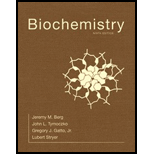
Concept explainers
(a)
Interpretation:
The most sensitive member of the ASIC family to toxin needs to be determined.
Concept introduction:
The acid sensing ion channels which are commonly known as ASIC are the proton sensing channels present in the central nervous system which are reactive towards a variety of complex behaviors such as fear, anxiety, pain, depression, leaning and sensitivity.ASIC1a, ASIC1b, ASIC2a, ASIC2b, ASIC3, and ASIC4 are six different subunits of such acid sensing ion channels.
(b)
Interpretation:
Whether the effect of the toxin is reversible or irreversible needs to be explained.
Concept introduction:
The acid sensing ion channels which are commonly known as ASIC are the proton sensing channels present in the central nervous system which are reactive towards a variety of complex behaviors such as fear, anxiety, pain, depression, leaning and sensitivity.
(c)
Interpretation:
The percentage of PcTx1 that yields 50% inhibition of the sensitive channel needs to be determined.
Concept introduction:
The acid sensing ion channels which are commonly known as ASIC are the proton sensing channels present in central nervous system which are reactive towards a variety of complex behaviors such as fear, anxiety, pain, depression, leaning and sensitivity.
Want to see the full answer?
Check out a sample textbook solution
Chapter 13 Solutions
Biochemistry (Looseleaf)
- Match the three types of neurotransmitters to their relative size (largest to smallest): Largest Peptide neurotransmitter ✓ Second largest [Choose] Smallest > [Choose ] [Choose ] Amino acid neurotransmitter Peptide neurotransmitter Amine neurotransmitterarrow_forwardneed help not sure why its wrong please helparrow_forwardWhy the 2nd choice is correct?arrow_forward
- a) What are the differences between the Direct & Indirect Immunofluorescence Assays? (0.5 mark) b) What are the advantages of the Indirect Immunofluorescence Assays? (0.5 mark) c) A Super-Resolution Imaging Technique was developed in 2018 using imidazole, a His-tag ligand conjugated with a fluorophore to report the presence of a recombinant His-tag protein target, (Sci Rep, 2018, 8:5507). How does this technique improve the image quality? (2 marks)arrow_forwarda) What are the differences between the Direct & Indirect Immunofluorescence Assays? b) What are the advantages of the Indirect Immunofluorescence Assays? c) A Super-Resolution Imaging Technique was developed in 2018 using imidazole, a His-tag ligand conjugated with a fluorophore to report the presence of a recombinant His-tag protein target, (Sci Rep, 2018, 8:5507). How does this technique improve the image quality?arrow_forwardCalculate the number of ATP produced from oxidation of 1 molecule of glucosearrow_forward
- Example 1: 1. Suppose an enzyme (MW = 5,000 g/mole) has a concentration of 0.05 mg/L. If the kcat is 1 x 10 s, what is the theoretical maximum reaction velocity for the enzyme? A) 1050 µM/s. B) 100 µM/s. C) 150 μM/s. D) 105 μM/s.arrow_forwardIn 1956, E. P. Kennedy and S. B. Weiss published their study of membrane lipid phosphatidylcholine (lecithin) synthesis in rat liver. Their hypothesis was that phosphocholine joined with some cellular component to yield lecithin. In an earlier experiment, incubating 32 P-labeled phosphocholine at physiological temperature (37 °C) with broken cells from rat liver yielded labeled lecithin. This became their assay for the enzymes involved in lecithin synthesis. Determine the optimal pH for this enzyme and characterize the enzyme activity at different pH values. -O-P-O-CH2-CH₁₂-N(CH3)3 Phosphocholine H₂C-O-C-R HC-O-C-R2 + + + Cell fraction + ? HC-O-P-O-CH₁₂-CH₂-N(CH), O Phosphatidylcholine The researchers then centrifuged the broken cell preparation to separate the membranes from the soluble proteins. They tested three preparations: whole extract, membranes, and soluble proteins. Table 1 summarizes the results. Table 1: Cell fraction requirement for incorporation of 32p-phosphocholine into…arrow_forwardResearchers isolated an unknown substance, X, from rabbit muscle. They determined its structure from the following observations and experiments. (a) Qualitative analysis showed that X was composed entirely of C, H, and O. A weighed sample of X was completely oxidized and the H2O and CO2 produced were measured. This quantitative analysis revealed that X contained 40.00% C, 6.71% H, and 53.29% O by weight. (b) The molecular mass of X, as determined by mass spectrometry, was 90.00 atomic mass units (u). (c) Infrared spectroscopy showed that X contained one double bond. (d) X dissolved readily in water, and the solution demonstrated optical activity when tested in a polarimeter. (e) The aqueous solution of X is acidic. What is the empirical formula of X?arrow_forward
- Show work. don't give Ai generated solution....give correct solutionarrow_forwardBiochemistry What is the process of "transamination" in either the muscles or the liver, that involves keto acid or glutamic acid? Please explain how the steps work. Thank you!arrow_forwardBiochemistry Please help. Thank you What is the importance of glutamic acid in the metabolism of nitrogen from amino acids? (we know therole; it’s used to remove the nitrogen from amino acids so that the remaining carbon skeleton can bebroken down by the “usual” pathways, but what is the important, unique role that only glutamicacid/glutamate can do?)arrow_forward
 BiochemistryBiochemistryISBN:9781305577206Author:Reginald H. Garrett, Charles M. GrishamPublisher:Cengage Learning
BiochemistryBiochemistryISBN:9781305577206Author:Reginald H. Garrett, Charles M. GrishamPublisher:Cengage Learning Biology: The Dynamic Science (MindTap Course List)BiologyISBN:9781305389892Author:Peter J. Russell, Paul E. Hertz, Beverly McMillanPublisher:Cengage Learning
Biology: The Dynamic Science (MindTap Course List)BiologyISBN:9781305389892Author:Peter J. Russell, Paul E. Hertz, Beverly McMillanPublisher:Cengage Learning Biology (MindTap Course List)BiologyISBN:9781337392938Author:Eldra Solomon, Charles Martin, Diana W. Martin, Linda R. BergPublisher:Cengage Learning
Biology (MindTap Course List)BiologyISBN:9781337392938Author:Eldra Solomon, Charles Martin, Diana W. Martin, Linda R. BergPublisher:Cengage Learning BiochemistryBiochemistryISBN:9781305961135Author:Mary K. Campbell, Shawn O. Farrell, Owen M. McDougalPublisher:Cengage Learning
BiochemistryBiochemistryISBN:9781305961135Author:Mary K. Campbell, Shawn O. Farrell, Owen M. McDougalPublisher:Cengage Learning





